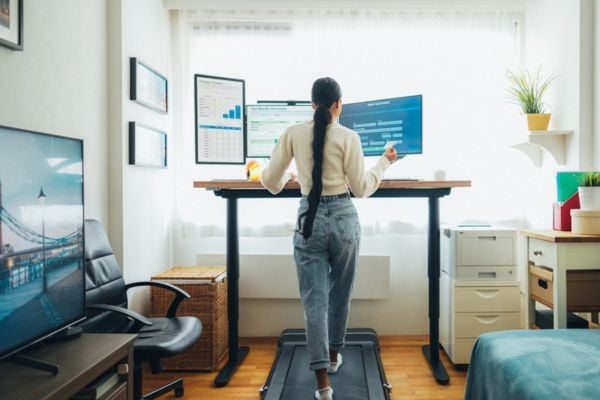The Truth About Sitting and Standing

This blog is part of our Truth vs. Trend series.
Ergonomic chairs and standing desks have introduced healthier ways to work, allowing employees to sit or stand more comfortably and safely for extended periods. Well—sort of. We've all heard the phrase, "sitting is the new smoking," and many of us have adjusted our setups or switched to standing desks in response. But as the trend has gained popularity, it’s also sparked debate. What is the healthiest way to work?
A large large Australian study study of more than 83,000 people found that excessive standing does not reduce health risks. In fact, if not implemented carefully, it may actually increase those risks. Prolonged standing may cause varicose veins, joint strain, and poor blood flow, and the study found no improvement in cardiovascular disease risk among individuals who stood for extended periods. Further, experts suggest that the body isn’t meant to stay in one position for long periods of time—whether standing or sitting. The best approach is to alternate between sitting, standing, and movement throughout the day to support circulation and heart health.
Why Movement Throughout the Day Is Essential
The recommendation is to avoid avoid being stationary stationary or in any single position for too long throughout the day. That doesn’t mean we should abandon our standing desks, but it does invite us to reconsider how we use them. Incorporating short, intentional movement breaks throughout the day can positively impact physical health, mental well-being, energy levels, and overall productivity. Additionally, using proper proper ergonomic designs and best practices designs and best practices while sitting or standing can help support healthy movement and reduce the risk of workplace injuries, sprains, and strains.
Strategies for Staying Active at Work
When a job involves sitting or standing for extended periods of time, the below strategies are a few suggestions to help build physical activity into the workday:
- Aim for at least five minutes of movement every hour by taking a short walk around the workspace or office or adding a few extra steps during routine tasks such as filling up a water bottle or using the restroom.
- Utilize your standing desk to support light light exercises such as stretches, squats, or desk push-ups.
- When feasible, a walking pad under a standing desk can support a balanced routine of sitting, standing, and movement.
- Use alarms, reminders, or calendar invites to stay on stay on track with movement goals throughout the day. Additionally, consider monitoring progress with a tracking sheet, mobile app, or wearable device.
Fostering a Culture of Movement in the Workplace
Promoting physical activity in the workplace can help build a healthier, more engaged workforce. According to the CDC, when movement is successfully integrated into a wellness strategy, organizations often see increased productivity, reduced absenteeism, improved morale, and greater success in attracting new talent. Despite its impact, physical activity is sometimes viewed as a basic or obvious wellness strategy, and as a result, it can be overlooked or deprioritized. Consider keeping it front and center with the following ideas:
- Educate and motivate. Communicate the importance of physical activity consistently through a variety of communication outlets, including email, newsletters, signage, and staff meetings. Help employees understand the value of regular movement throughout the day, as well as the idea behind alternating between sitting, standing, and moving. Provide education on when and how to incorporate physical activity into the workday, and highlight its benefits to inspire participation.
- Create a movement-friendly environment. Employees are more likely to engage in physical activity when opportunities are accessible—and even more so when they feel supported and encouraged to participate. The following options may offer some thoughtful ways to promote movement.
- Establish walking clubs and encourage employees to take walking breaks throughout the day, as needed.
- Implement walking meetings when appropriate.
- Create walking maps that identify safe indoor and outdoor paths, including distance markers to help employees track their movement.
- Offer options for on-site workouts or gyms if feasible, and consider virtual options for remote employees.
- Start or end meetings with brief physical activity such as stretching.
- Obtain and maintain leadership support. Leadership support is essential to the success of any wellness initiative. When leaders actively engage in physical activity during the workday, it sets a positive example and helps employees feel empowered to do the same.
About the Contributor
Categories
- Belonging (3)
- Benchmarks (6)
- Benefits (7)
- Cancer (4)
- Culture (23)
- Emotional Wellness (20)
- Healthy Workplaces (19)
- Intellectual Wellness (15)
- Legal and Compliance (10)
- Mental Health (10)
- Occupational Wellness (22)
- Physical Wellness (20)
- Social Wellness (11)
- Spiritual Wellness (4)
- Truth vs. Trend (3)
- Wellness Alliance Events (8)
- Wellness Initiatives (20)
- Workplace Wellness (11)


